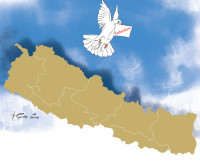Opinion
Lessons from a recent summit
The second Himalayan Consensus Summit concluded on Saturday. Attended by people from around the world, various ideas were put forth regarding what individuals can do to take incremental steps towards achieving one goal: the use of Himalayan ideas to help global prosperity.
Sujeev Shakya
The second Himalayan Consensus Summit concluded on Saturday. Attended by people from around the world, various ideas were put forth regarding what individuals can do to take incremental steps towards achieving one goal: the use of Himalayan ideas to help global prosperity. An event is a learning process; it reflects the society we live in, the aspirations we have, and the culture we want to pass on to the next generation. Thus, a lot can be learnt from the subjects that emerge in an event. What I have learnt is that it is easy to get the big things right, but the basics can continue to be a problem.
My learning of real life work began at what was then the Soaltee Group—a very structured professional organisation. We learnt how an invitation is very important and that responding to an invitation is even more important. Under the stewardship of Mr Prabhakar Rana, we learnt what dress codes meant, what timing meant, when to reach a destination and when to leave. We learnt how to behave, take notes, intervene and interact.
It’s not a wedding invitation
Now, invitations have been modernised from the form of cards in an envelope to electronic transmissions. Maybe our culture of inviting all and sundry to our social events to demonstrate who you know rather than who you want has diluted the meaning of invitation. People treat invitations to events much like they treat invitations for an acquaintance’s daughter’s wedding. If a person is interested in an event, then they should make an effort to attend it, as they reap more benefits from it than the organisers.
Similarly, if someone is not going to attend an event that one has been invited to, it is only good to tell the host that they are not going to make it. In Nepal, planning is not something we believe in. We give the hotel where an event is being held a certain number of guests, and twice as many people show up. We have even taken this cultural tendency abroad, as I have seen in many Nepali events around the world. I keep wondering—is it not important to plan and know how many people will attend, so that the organiser can give the hotel the right number and not get into trouble for having too many or too few people?
Formalities galore
There are two things that the Nepali society has imitated very well from our South Asian neighbours. One, we love the formalities that go into a function—speakers bedecked with garlands that resemble nooses in photos, ugly round tokens that punch holes in our jacket, long speeches that refer to the names of the people present, the unwritten protocol of such events and the request for special treatment for certain attendees who are erstwhile royalty. I have learned to avoid them. In the 21st century, we need to be business-like during the day and hold wonderful events that reflect our vibrant culture in the evenings.
Second, our definition and sense of entitlement conforms to that of our South Asian neighbours as well. One keeps wondering why there are so many people on stage at events. While this can happen in a religious function where hierarchy is the only norm, why extend it to the meetings of the private or the development sectors? We tell expatriates that this is a cultural practice, while amongst ourselves, we say that the boss wants it this way. It is a way to tell others that, in a democratic country, we are more equal than others.
Conducting an event without formalities and entitlement is important, as we do not want the youth aping the cultural practices that have divided societies more than united them. This culture has kept those seriously interested at home, while the undeserving ones fill the conference halls.
Age of narcissism
South Asian television channels featuring loud altercations and the advent of social media have converted many of us into narcissists. Nepali leaders from various spheres have cultivated an addiction to making senseless speeches and remarks on television channels during the day and watching their discourse on television at night. When television coverage was a new fad in Nepal, we were told that Nepal Television (the first channel of its kind) would only cover events if a minister was in attendance. We have not forgotten this mantra despite the addition of many new television channels.
Today, professionals are well-rehearsed in the art of reaching an audience—they know exactly what messages they want to spread among the targeted audience via specific mediums. Gone are the days when having 10 television cameras in front of a large panel was an indication of success. Whether targeting a mass audience or a niche global audience interested in a particular subject, the people who matter need to be reached in a way that is appealing to them. A press release to a media house is enough—follow up is not necessary, as they are the best judges of whether the subject is of interest to them. There are a lot of opportunities for young Nepalis to take up careers in communication, as people will start realising that they need to change the ways they get messages across.
The three lessons I learnt from the last weekend is that the world is changing
and the profile of people wanting to learn and interact is changing; that the way people want to come and listen to ideation while focusing on target segments is important; and that communication channels have changed from focusing on the superficial to delving deeply into issues. My learning continues.




 12.12°C Kathmandu
12.12°C Kathmandu
.jpg&w=200&height=120)







%20(1).jpg&w=300&height=200)

